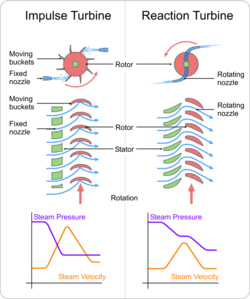impulse turbine

Impulse and reaction turbines compared.
An impulse turbine is a turbine that is driven by high velocity jets of water or steam from a nozzle directed on to vanes or buckets attached to a wheel. The resulting impulse (as described by Newton's second law of motion) spins the turbine and removes kinetic energy from the fluid flow. Before reaching the turbine the fluid's pressure head is changed to velocity head by accelerating the fluid through a nozzle. This preparation of the fluid jet means that no pressure casement is needed around an impulse turbine.
Most types of turbine exploit the principles of both impulse turbines and reaction turbines. However, a few, such as the Pelton turbine, use the impulse concept exclusively.
Main types of impulse turbine
Pelton
 |
A Pelton turbine has one or more free jets discharging water into an aerated space and impinging on the buckets of a runner. Draft tubes are not required for impulse turbine since the runner must be located above the maximum tailwater to permit operation at atmospheric pressure.
A Turgo turbine is a variation on the Pelton. The Turgo runner is a cast wheel whose shape generally resembles a fan blade that is closed on the outer edges. The water stream is applied on one side, goes across the blades and exits on the other side.
Cross-flow turbine
A cross-flow turbine is drum-shaped and uses an elongated, rectangular-section nozzle directed against curved vanes on a cylindrically shaped runner. It resembles a "squirrel cage" blower. The cross-flow turbine allows the water to flow through the blades twice. The first pass is when the water flows from the outside of the blades to the inside; the second pass is from the inside back out. A guide vane at the entrance to the turbine directs the flow to a limited portion of the runner. The cross-flow was developed to accommodate larger water flows and lower heads than the Pelton.
